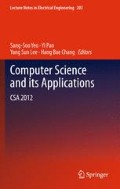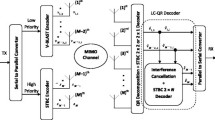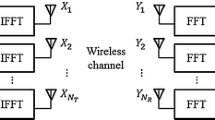Abstract
In this paper, a new low complexity detection algorithm for V-BLAST/STBC scheme based on QR decomposition, denoted as low complexity QR (LC-QR), is presented. The performance of the proposed LC-QR decomposition detection algorithm in V-BLAST/STBC transceiver scheme is investigated with other MIMO systems, such as ZF, MMSE and QR decomposition schemes. It is shown that the BER performance in V-BLAST/STBC scheme is better than V-BLAST scheme while its system capacity is higher than orthogonal STBC scheme when the LC-QR is exploited.
Similar content being viewed by others
Keywords
1 Introduction
The V-BLAST/STBC scheme, which was introduced in [1] is a combination of the Alamouti’s Space–Time Block Code (STBC) and Vertical Bell Laboratories Layered Space–Time (V-BLAST) schemes. A number of research efforts on V-BLAST/STBC scheme have been carried for Multiple-Input Multiple-Output (MIMO) antenna system with the goal of maximizing the system capacity and reducing its bit error rate (BER). The V-BLAST/STBC scheme improves the performance of MIMO by combining spatial multiplexing and diversity technique together [2]. However, the spatially-multiplexed V-BLAST and STBC layers in the V-BLAST/STBC scheme assume each other as interferer. Therefore, the transmitted symbols must be decoded with well-known detection techniques such as zero-forcing (ZF), minimum mean-squared error (MMSE) and QR decomposition which are employed in V-BLAST scheme [3]. The QR decomposition of A × B channel matrix H is a factorization H = QR, where Q is A × B unitary matrix and R is B × B upper triangular matrix. The computational implementation of QR decomposition is less than ZF and MMSE [4], thus the complexity of V-BLAST/STBC scheme can be reduced using QR decomposition.
In this paper, a new detection algorithm based on QR decomposition, denoted as low complexity QR (LC-QR), is presented. The computational complexity (total number of arithmetic operations) of the proposed LC-QR algorithm will be significantly lower than the conventional ZF, MMSE and QR decomposition detection algorithms. The performance of V-BLAST/STBC transceiver scheme with proposed LC-QR algorithm is compared with other MIMO systems, such as V-BLAST and orthogonal space–time block codes. The BER performance of V-BLAST/STBC scheme is better than V-BLAST scheme while the system capacity of V-BLAST/STBC scheme is higher than STBC scheme when the LC-QR is exploited.
2 Proposed Low Complexity V-BLAST/STBC Detection Algorithm with QR Decomposition
The block diagram of a V-BLAST/STBC transceiver model with M (M ≥ 3) transmit and N (N ≥ M − 1) receive antennas is shown in Fig. 1. A single main data stream is de-multiplexed into two sub-data streams according to the data priority. The high priority data is assigned to STBC layer for extra gain while low priority data is sent to V-BLAST layer with higher capacity. The proposed LC-QR detection algorithm with M transmit and N receive antennas is discussed in detail in this section. Instead of decoding the transmitted symbols with the equivalent channel matrix H with dimension 2 N × 2(M − 1), the original channel matrix H with dimension N × M is utilized. If N < M − 1, the LC-QR algorithm is invalid and not applicable. The flow chart of LC-QR algorithm is shown in Fig. 2.
3 Comparison of the Complexity of LC-QR with ZF, MMSE and QR Decomposition Algorithms
The complexity of ZF, MMSE, QR decomposition with H and LC-QR with H is analyzed here. It is assumed that the channel matrix H with dimension N × M is used to analyze the complexity of the LC-QR. The equivalent channel matrix H with dimension 2 N × 2(M − 1) is used to analyze the complexity of ZF, MMSE and QR decomposition. It is observed that there are zeros in channel matrix H, therefore the multiplication and addition with zero are not taken into account in ZF and MMSE complexity calculation. The comparison of number of complex arithmetic operation and reduction of complexity for ZF, MMSE, QR decomposition with H and LC-QR detection algorithm with H is shown in Tables 1 and 2 respectively. From Table 2, it can be observed that the proposed LC-QR detection algorithm significantly reduces the arithmetic complexity compared to ZF, MMSE and QR decomposition algorithm.
4 Performance of Proposed Low Complexity QR Decomposition
Simulations have been performed for MIMO system using MATLAB to evaluate the performance of the V-BLAST/STBC scheme for ZF, MMSE and QR decomposition with H and LC-QR with H in terms of BER. The 4-ary quadrature amplitude modulation (4-QAM) constellation is used in these simulations with Rayleigh flat-fading channel for Figs. 3 and 5 as well as Naftali channel [5] for the rest of the figures. The entries of Rayleigh flat-fading channel matrix are circularly symmetric, i.i.d. Gaussian random variables with zero-mean and unit variance.
Figure 3 shows the BER performance comparison of ZF V-BLAST 4 × 4, O-STBC 4 × 4 with rate 3/4 and V-BLAST/STBC 4 × 4 with LC-QR in Rayleigh flat-fading channel environment, which is constant across four consecutive symbol transmission periods. It could be seen that BER performance of O-STBC 4 × 4 with symbol rate 3/4 is the best among the considered schemes as it is a pure spatial diversity scheme with full diversity gain. Moreover, O-STBC does not suffer from inter-symbol interference (ISI) as the transmitted symbols are orthogonal to one another. In contrast, ZF V-BLAST 4 × 4 with symbol rate four is the worst among the schemes because it is a pure spatial multiplexing scheme which suffers from poor diversity gain. Besides, interference between transmitted symbols in ZF V-BLAST scheme greatly reduces the BER performance. It can be seen that the V-BLAST/STBC 4 × 4 with symbol rate three shows a compromise of BER performance with respect to pure spatial multiplexing or diversity scheme.
Figure 4 depicts the 10 and 1 % outage capacity for basic MIMO (theoretical limit), ZF V-BLAST, O-STBC and V-BLAST/STBC with LC-QR in 4 × 4 system. The spectral efficiency of ZF V-BLAST changes a lot with different outage probability. For instance, ZF V-BLAST requires 8 dB to maintain the capacity of 15 bps/Hz when it proceeds from 10 to 1 % outage probability. This is caused by lack of diversity of ZF V-BLAST. In contrast, the V-BLAST/STBC with LC-QR just requires 3 dB to maintain at the capacity of 15 bps/Hz. Last but not least, the O-STBC is the most stable one, as the curve of 10 % outage capacity is very close to the curve of 1 % outage capacity. Besides, it can be observed that the capacity of ZF V-BLAST with 10 % outage probability is the highest among the considered schemes for SNR higher than 37 dB.
It can be concluded that Figs. 3 and 4 present the tradeoffs among ZF V-BLAST, O-STBC and V-BLAST/STBC with LC-QR in 4 × 4 system. The O-STBC achieves the best BER performance but the system capacity is the lowest among the schemes. The system capacity of ZF V-BLAST with 10 % outage capacity is the highest for SNR above 37 dB but the BER performance is the worst among the schemes. In contrast, the system capacity of V-BLAST/STBC with LC-QR is close to MIMO and better than ZF V-BLAST for SNR below 37 dB. Moreover, the BER performance of V-BLAST/STBC with LC-QR is significantly better than ZF V-BLAST as V-BLAST/STBC achieves spatial multiplexing and diversity gain simultaneously.
Figure 5 shows the BER performance of various algorithms in V-BLAST/STBC scheme with Rayleigh flat-fading channel model, which is constant across two consecutive symbol transmission periods. The LC-QR 3 × 2 with H outperforms ZF 3 × 2 and MMSE 3 × 2 with H by more than 2 dB gain at BER of 10−3 [6]. At the same time, the LC-QR 3 × 2 with H outperforms QR 3 × 2 with H by approximately 1.5 dB gain at BER of 10−3. This is because the estimated candidate of STBC layer, which is more robust than V-BLAST layer, is decoded first. After decoding the estimated candidate of STBC layer, interference cancellation activity is performed to produce a new modified received signal matrix with less interference. For ZF and MMSE algorithm, there is no interference cancellation activity. It is clear that V-BLAST layer performance dominates over final decision of STBC layer. With increasing SNR, the probability of error in decoding the V-BLAST layer is reduced, the probability of correct decoding is increased at the STBC layer. As the V-BLAST layer transmits four data symbols while STBC layer transmits two data symbols over two consecutive symbol transmission periods, thus a better BER performance of V-BLAST layer with LC-QR leads to overall V-BLAST/STBC system performance improvement.
Figure 6 illustrates the BER performance comparison of various algorithms in V-BLAST/STBC scheme with Naftali channel model under different maximum delay spread environment. The LC-QR outperforms ZF and MMSE by approximately 2 dB gain at BER of 10−3 for both indoor (200 ns) and outdoor (1.6 μs) environment. At the same time, the LC-QR 4 × 4 outperforms QR 4 × 4 by approximately 1 dB gain at BER of 10−3 for both indoor and outdoor environment. In order to maintain the BER of 10−3, the LC-QR with maximum delay spread = 1.6 μs requires 6 dB gain compared to indoor environment with maximum delay spread = 200 ns.
5 Conclusions
In this paper, it is illustrated that V-BLAST/STBC scheme, which achieves spatial multiplexing and diversity gain simultaneously, increases system capacity to accommodate the ever growing demand for real time system with tolerably lower QoS. It is also shown that the system capacity of V-BLAST/STBC scheme is close to MIMO and better than ZF V-BLAST for SNR below 37 dB. Moreover, a new V-BLAST/STBC detection algorithm that utilizes LC-QR decomposition has been introduced. The LC-QR significantly reduces the arithmetic operation complexity and remains a satisfactory BER performance compared to ZF, MMSE, QR decomposition, SIC ZF, SIC MMSE and sorted QR decomposition.
References
Mao, T., Motani, M.: STBC-VBLAST for MIMO wireless communication systems. In: IEEE International Conference on Communications (ICC 2005), vol. 4, pp. 2266–2270 (2005)
Longoria-Gandara, O., Sanchez-Hernandez, A., Cortez, J., Bazdresch, M., Parra-Michel, R.: Linear dispersion codes generation from hybrid STBC-VBLAST architectures. In: 4th International Conference Electrical and Electronics Engineering (ICEEE 2007), pp 142–145 (2007)
Sandeep, G., Ravi-Teja, C., Kalyana-Krishnan, G., Reddy, V.U.: Low Complexity Decoders for Combined Space Time Block Coding and V-BLAST, Wireless Communications and Networking Conference (WCNC 2007), pp. 582–587 (2007)
Wai, W.K., Tsui, C.Y., Cheng, R.S.: A low complexity architecture of the V-BLAST system. In: Proceeding of IEEE Wireless Communications and Networking Conference, vol. 1, pp. 310–314 (2000)
Noordin, N.K., Ali, B.M., Jamuar, S.S., Ismail, M.: Space-time and space-frequency OFDM with convolutional precoding over fading channels. In: IEEE Region 10 Conference (TENCON 2008), pp. 1–6 (2008)
Liu, L., Wang, Y.Z.: Spatially selective STBC-VBLAST in MIMO communication system. In: International Conference on Communications, Circuits and Systems (ICCCAS 2008), pp. 195–199 (2008)
Author information
Authors and Affiliations
Corresponding author
Editor information
Editors and Affiliations
Rights and permissions
Copyright information
© 2012 Springer Science+Business Media Dordrecht
About this paper
Cite this paper
Chong, J.H., Ng, C.K., Noordin, N.K., Mohd. Ali, B. (2012). A Low Complexity V-BLAST/STBC Detection Algorithm for MIMO System. In: Yeo, SS., Pan, Y., Lee, Y., Chang, H. (eds) Computer Science and its Applications. Lecture Notes in Electrical Engineering, vol 203. Springer, Dordrecht. https://doi.org/10.1007/978-94-007-5699-1_7
Download citation
DOI: https://doi.org/10.1007/978-94-007-5699-1_7
Published:
Publisher Name: Springer, Dordrecht
Print ISBN: 978-94-007-5698-4
Online ISBN: 978-94-007-5699-1
eBook Packages: Computer ScienceComputer Science (R0)










